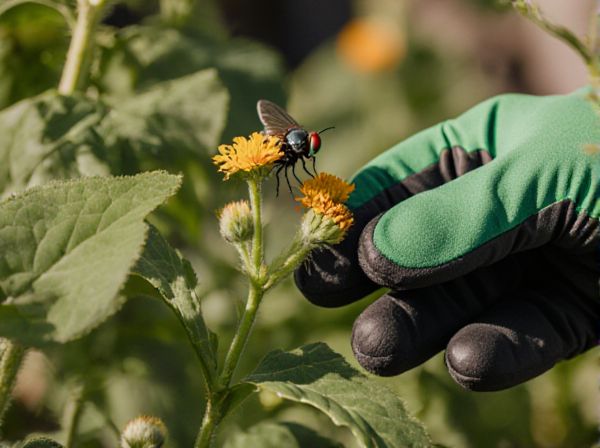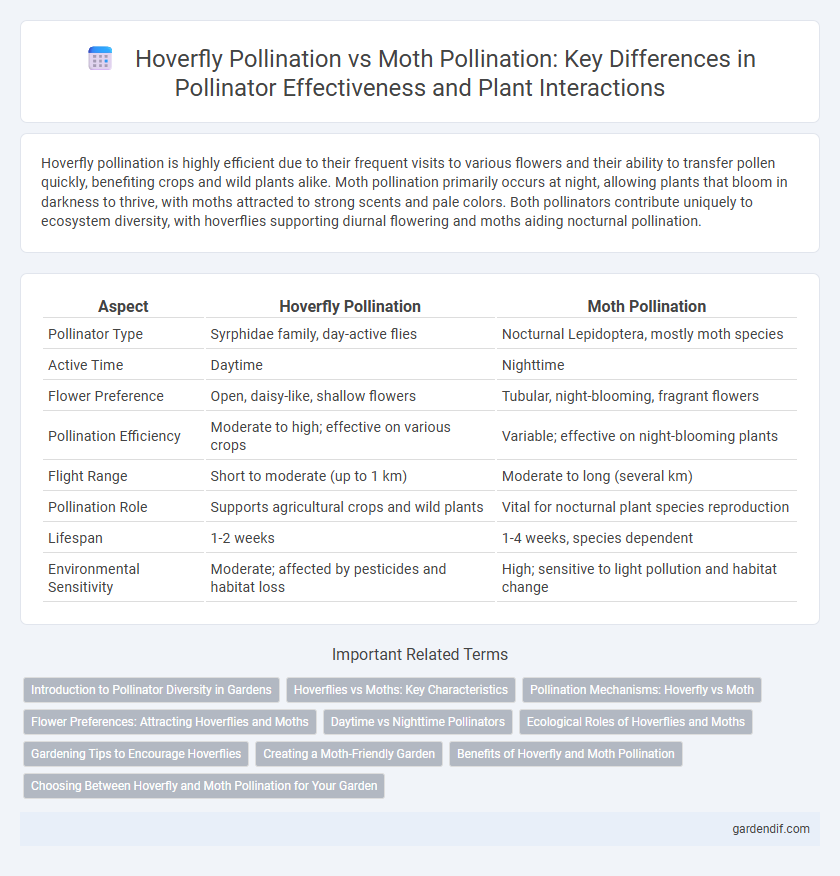
Hoverfly pollination vs moth pollination Illustration
Hoverfly pollination is highly efficient due to their frequent visits to various flowers and their ability to transfer pollen quickly, benefiting crops and wild plants alike. Moth pollination primarily occurs at night, allowing plants that bloom in darkness to thrive, with moths attracted to strong scents and pale colors. Both pollinators contribute uniquely to ecosystem diversity, with hoverflies supporting diurnal flowering and moths aiding nocturnal pollination.
Table of Comparison
| Aspect | Hoverfly Pollination | Moth Pollination |
|---|---|---|
| Pollinator Type | Syrphidae family, day-active flies | Nocturnal Lepidoptera, mostly moth species |
| Active Time | Daytime | Nighttime |
| Flower Preference | Open, daisy-like, shallow flowers | Tubular, night-blooming, fragrant flowers |
| Pollination Efficiency | Moderate to high; effective on various crops | Variable; effective on night-blooming plants |
| Flight Range | Short to moderate (up to 1 km) | Moderate to long (several km) |
| Pollination Role | Supports agricultural crops and wild plants | Vital for nocturnal plant species reproduction |
| Lifespan | 1-2 weeks | 1-4 weeks, species dependent |
| Environmental Sensitivity | Moderate; affected by pesticides and habitat loss | High; sensitive to light pollution and habitat change |
Introduction to Pollinator Diversity in Gardens
Hoverflies contribute significantly to pollination in gardens with their ability to hover and transfer pollen efficiently, especially benefiting early spring flowers. Moths, active mostly at dusk or night, complement this by pollinating nocturnal blossoms that other insects rarely visit. Garden biodiversity thrives when both hoverflies and moths coexist, ensuring a wider range of flowering plants receive effective pollination across different times of day.
Hoverflies vs Moths: Key Characteristics
Hoverflies exhibit rapid, agile flight and frequently visit flowers during the day, making them efficient diurnal pollinators with a preference for open, brightly colored blooms. Moths primarily pollinate at night, demonstrating strong attraction to pale or white, strongly scented flowers adapted for nocturnal pollination. Hoverflies utilize their sponge-like mouthparts for nectar feeding, while moths often possess long proboscises to access deep floral nectaries.
Pollination Mechanisms: Hoverfly vs Moth
Hoverflies perform pollination by rapidly visiting a variety of flowers during daylight, using their sponging mouthparts to extract nectar while transferring pollen on their hairy bodies. Moths primarily pollinate at night, employing a specialized proboscis to reach deep floral nectaries, facilitating pollen transfer through contact with anthers and stigmas during their feeding. The diurnal activity and hovering flight of hoverflies contrast with the nocturnal, often slower flight of moths, influencing the types and structure of flowers they pollinate.
Flower Preferences: Attracting Hoverflies and Moths
Hoverflies primarily target flowers with open, flat structures like umbels and simple composite blooms that provide easy access to nectar and pollen. Moths prefer tubular, fragrant flowers that bloom at dusk or nighttime, leveraging their long proboscises to reach deep floral nectaries. Optimizing garden plantings with diverse floral shapes and nectar availability enhances both hoverfly and moth pollination efficiency.
Daytime vs Nighttime Pollinators
Hoverflies are efficient daytime pollinators, frequently visiting flowers during daylight hours when nectar and pollen availability is highest, thereby enhancing crop yields and biodiversity. Moths predominantly serve as nighttime pollinators, relying on nocturnal floral cues such as scent and pale color to locate flowers when diurnal pollinators like hoverflies are inactive. The distinction between hoverfly and moth pollination reflects adaptations to environmental light conditions, optimizing pollination across the full day-night cycle and supporting ecosystem resilience.
Ecological Roles of Hoverflies and Moths
Hoverflies contribute significantly to pollination by visiting a wide range of flowering plants, enhancing biodiversity and crop production through their efficient pollen transfer. Moths, active mainly at night, support nocturnal pollination networks by visiting flowers that release scent and nectar after dusk, thus complementing daytime pollinators. The combined ecological roles of hoverflies and moths ensure continuous pollination across diurnal and nocturnal periods, maintaining ecosystem stability and resilience.
Gardening Tips to Encourage Hoverflies
Hoverflies are efficient pollinators that thrive in gardens with abundant flowering plants like marigolds, alyssum, and dill, which provide nectar and pollen sources. Unlike nocturnal moth pollination, hoverflies are active during the day and require safe habitats with minimal pesticide use and access to water for optimal activity. To encourage hoverflies, gardeners should plant diverse, insect-friendly flora and maintain organic gardening practices that support hoverfly larvae, which help control aphid populations naturally.
Creating a Moth-Friendly Garden
Hoverflies contribute significantly to pollination by visiting a wide range of flowers during the day, while moths primarily pollinate nocturnal blooms with their long proboscises adapted for deep corollas. Creating a moth-friendly garden involves planting night-blooming flowers such as evening primrose, jasmine, and moonflowers, which release strong scents to attract moths after dusk. Incorporating native plant species and minimizing artificial light pollution enhances moth activity, supporting biodiversity and effective pollination.
Benefits of Hoverfly and Moth Pollination
Hoverfly pollination enhances crop yields by providing efficient pollination through their ability to visit flowers frequently and in diverse habitats, contributing to increased biodiversity and ecosystem resilience. Moth pollination benefits nocturnal plants by enabling pollination during night hours, supporting species that rely on night-blooming flowers and maintaining nighttime ecosystem functions. Both hoverflies and moths play critical roles in pollination networks, ensuring continuous pollination across different times of day and environmental conditions.
Choosing Between Hoverfly and Moth Pollination for Your Garden
Hoverfly pollination offers efficient daytime flower visitation with high adaptability to various garden plants, promoting rapid pollen transfer and improved fruit set. Moth pollination excels in night-blooming plant species, supporting nocturnal ecosystems with specialized floral relationships and extended pollen dispersal periods. Selecting hoverfly or moth pollination depends on garden plant species, bloom timing, and desired pollination efficiency for optimal garden biodiversity.
Hoverfly pollination vs moth pollination Infographic

 gardendif.com
gardendif.com